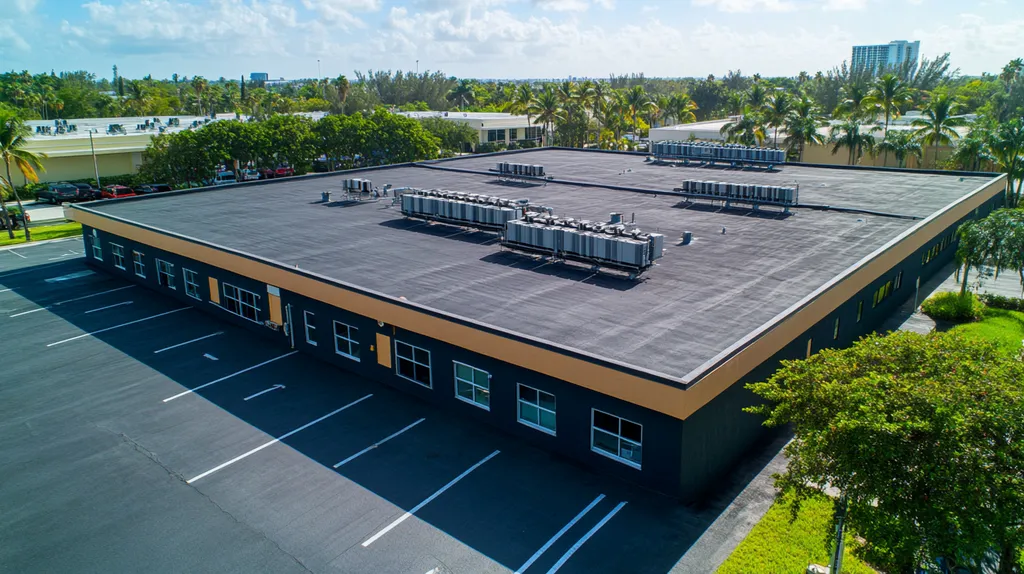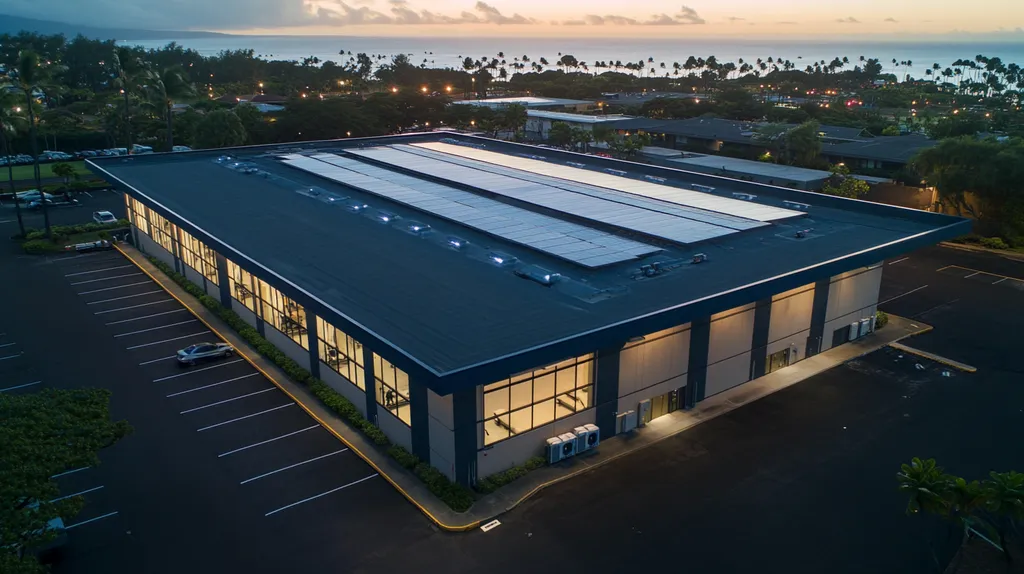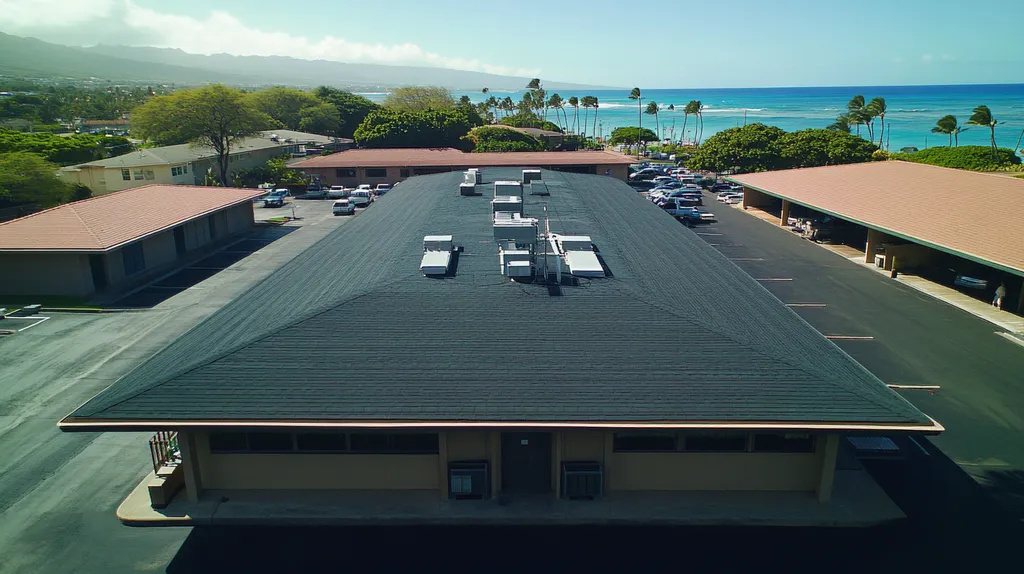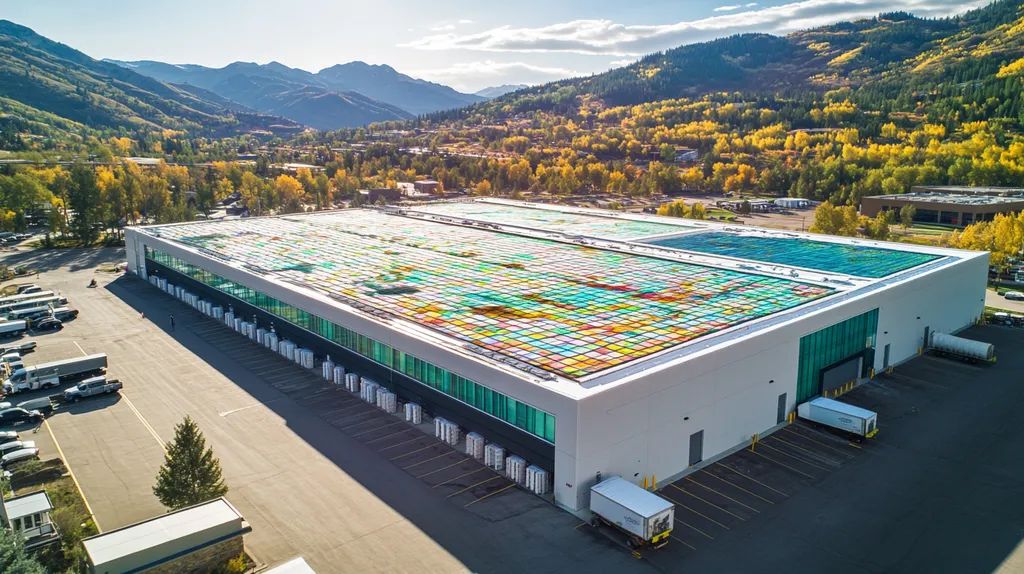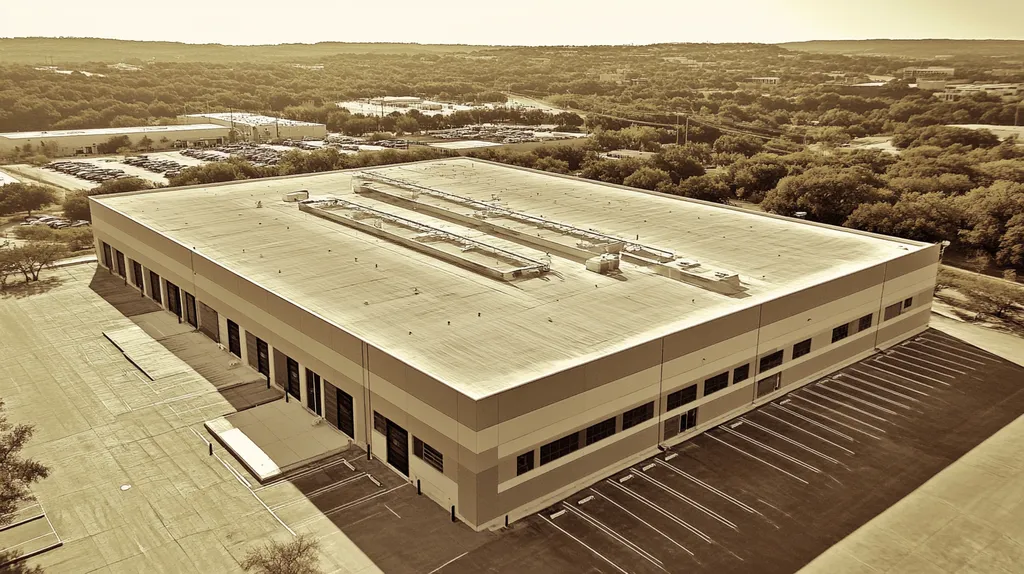Commercial roof coating projects cost U.S. businesses over $2 billion annually in operational disruptions, yet conventional strategies to minimize downtime often create more problems than they solve.
While quick-response guarantees and rapid-cure materials promise faster completion, these approaches frequently lead to compromised quality, safety risks, and extended facility closures.
This analysis examines why traditional downtime reduction methods fall short and presents data-driven solutions that better serve both property owners and the broader community.
SECTION 1: CURRENT PRACTICES
Reducing downtime during commercial roof coating projects is vital for property owners, as studies reveal that businesses may incur losses of $5,000 to $25,000 for each day operations are interrupted. This substantial financial impact highlights the urgent need for strategies that effectively minimize disruptions. Unfortunately, current practices often miss the mark, focusing on quick response guarantees, efficient material choices, and broad disruption minimization while overlooking the root causes of downtime.
Quick Response Guarantees
Quick response guarantees are frequently promoted by roofing companies as a means to alleviate downtime. The promise is enticing: immediate assistance will be provided whenever issues arise, which seems to minimize potential disruptions.
However, many property owners find that these guarantees often fall short. When problems do emerge, contractors may still need considerable time to evaluate the situation before initiating any substantial repair work. This assessment period can effectively prolong delays, contradicting the very purpose of the guarantee.
Moreover, issues can be exacerbated when contractors lack adequate experience or resources to manage complex scenarios. Such mismatches can lead to further delays, leaving businesses exposed to additional operational challenges.
Ultimately, an overreliance on quick response guarantees may prove inadequate for effective downtime management during roof coating projects. A comprehensive approach is required to meet the urgent needs of property owners while ensuring swift and reliable service.
Efficient Material Choices
Efficiency in material selection is a common focus for many roofing projects, with materials labeled as ‘quick-dry’ or ‘fast-cure’ promising shorter installation times.
While these materials can provide some reduction in on-site time, they often carry significant limitations. For example, fast-setting coatings may lack the long-term durability necessary for commercial applications, potentially leading to expensive repairs down the line.
Furthermore, efficient materials might require specific weather conditions to achieve their intended performance, introducing unpredictable delays. This focus on speed can unwittingly result in more issues than benefits if the materials do not meet expectations.
Consequently, selecting materials for roofing projects necessitates careful evaluation that goes beyond mere installation speed. A balanced and thoughtful approach can yield more favorable results and substantially lessen downtime.
Minimizing Business Disruptions
Efforts to minimize business disruptions during roofing projects often focus on scheduling work outside of regular hours, such as evenings or weekends. However, this strategy can introduce significant hurdles.
After-hours work often increases costs for property owners due to higher labor rates and can lead to diminished efficiency as crews rush to complete tasks within a limited timeframe. This added pressure raises the risk of mistakes, which can inadvertently extend project timelines.
Additionally, operating outside of standard hours can complicate coordination. Communication between contractors and facility managers may suffer, making it difficult to provide timely updates and make informed decisions.
Therefore, while it is crucial to minimize disruptions, a strategic approach that aligns contractor capabilities with the specific needs of the business is essential. This alignment can facilitate smooth operation during both roofing projects and daily business activities, protecting organizational productivity.
SECTION 2: SYSTEMIC ISSUES
Delays in commercial roof coating projects can inflict serious financial damage. Studies indicate that inefficiencies can drive project overruns up by an average of 30%, leading to unexpected costs. It’s vital for property owners and facility managers to recognize and understand these underlying issues that contribute to delays. By tackling these challenges, organizations can cut both downtime and financial strain. This section explores three critical systemic issues: delays and their financial impacts, safety risks and compliance, and inadequate communication.
Delays and Financial Impacts
Delays during roofing projects can trigger a domino effect of unplanned expenses. From equipment rentals to increased labor costs, budgets can easily spiral out of control when projects take longer than anticipated. Moreover, prolonged timelines can result in penalties or lost revenue from disrupted operations.
Extended facility downtime doesn’t just harm finances; it also disrupts operational capabilities. Businesses risk missing critical production schedules and losing valuable opportunities. For instance, if a manufacturing plant can’t operate due to roof repairs, the impact can extend beyond immediate costs to long-term customer relationships.
Additionally, neglecting minor roof issues can lead to larger problems over time. What starts as a small leak may escalate into a need for expensive repairs or even a complete roof replacement. Recognizing these financial repercussions underscores the necessity of proactive management and planning.
Investing in thorough planning and advanced scheduling techniques can reduce delays and their associated costs significantly. By anticipating potential setbacks, property owners can create effective contingency plans that protect the bottom line.
Safety Risks and Compliance
The safety of workers during roof coating projects is paramount. Workers face serious hazards such as falls and equipment-related injuries, making adherence to safety protocols essential. When safety measures are inadequate or overlooked, not only are workers at risk, but the consequences can be severe for the project as well.
Compliance with OSHA regulations is crucial; failing to meet these standards can lead to significant penalties and inflated insurance costs, further straining project budgets. A commitment to safety goes beyond legal obligations—it demonstrates a genuine concern for the workforce’s well-being.
Delays stemming from safety compliance issues can compound project timelines. If inspections are infrequent or missed, corrections could extend the project duration, resulting in increased downtime and costs. Thus, addressing safety and compliance during the planning phase can streamline project execution and enhance productivity.
Inadequate Communication
Effective communication is essential in avoiding project delays and misunderstandings. When teams fail to share critical information, confusion can arise regarding schedules, scope, and responsibilities, leading to errors that further hinder progress.
Regular updates and clear communication protocols between all stakeholders are vital for the smooth execution of any roofing project. Everyone involved needs to have a clear understanding of their roles and responsibilities to foster informed decision-making. A breakdown in communication significantly increases the risk of costly mistakes.
Additionally, when communication falters, responding swiftly to challenges becomes nearly impossible. Timely actions are crucial to mitigating potential setbacks; thus, structured communication systems are necessary to keep all parties aligned on the project goals.
Utilizing project management tools can enhance transparency and accountability throughout the roofing process, keeping the focus on successful outcomes and minimizing risks associated with miscommunication.
SECTION 3: MISSED OPPORTUNITIES
In the high-stakes environment of commercial operations, minimizing downtime during roof coating projects is more than just an operational priority—it’s essential for preserving both finances and future capabilities. Yet, many property owners fail to recognize critical opportunities that can enhance the longevity and efficiency of their roofs. Overlooking these chances not only affects immediate expenses but also threatens the long-term sustainability of their investments. Focusing on preventive maintenance, energy efficiency, and environmental benefits is crucial for a comprehensive, forward-thinking roofing strategy.
Preventive Maintenance Oversights
Many facilities managers tend to favor quick fixes instead of committing to long-term solutions regarding roofing. By neglecting regular inspections, they expose themselves to potentially severe issues that could require extensive—and costly—repairs. A facility that discovers a leak only after the roof has been coated illustrates how preventive maintenance can save both time and money.
During the roofing process, there are ample opportunities to tackle existing wear and tear. Ignoring these issues can lead to progressive deterioration that ultimately shortens the roof’s useful life. To combat this, property owners should incorporate routine assessments into their maintenance schedules, allowing for fast identification of potential problems.
Additionally, failing to maintain a roof adequately can void warranties on newly applied coatings. A poorly maintained roof, whether before or after coating, may not perform to its full potential, resulting in costly premature replacements.
To guard against these oversights, property owners should integrate maintenance strategies during the coating phase. Utilizing this project timeline for inspections and repairs not only reinforces the roof’s integrity but also optimizes the investment made in new coatings.
Energy Efficiency Gaps
Roof coating projects present a valuable opportunity for commercial properties to enhance energy efficiency. Many advanced coatings are specifically designed to reflect solar heat, which can lead to significant reductions in cooling costs. Unfortunately, property owners often undervalue these benefits, opting for traditional coating solutions instead.
Inadequate reflection of heat can result in increased energy consumption. Research indicates that reflective coatings can reduce energy costs by as much as 30%. By defaulting to conventional coatings, managers may overlook substantial long-term savings.
Failing to explore energy-efficient materials can also inhibit a facility’s overall sustainability goals. As businesses increasingly strive to meet higher environmental standards, the choice of roofing materials becomes pivotal for building performance.
By prioritizing reflective materials, managers not only minimize downtime during the coating process but also bolster energy efficiency. Educating themselves on available technologies will empower property owners to make choices that lower operating expenses and support the environment.
Environmental Benefits Ignored
Environmental considerations are becoming increasingly important in roofing decisions today. Many eco-friendly coating products exist but are often dismissed by property owners focused solely on budget constraints. This oversight neglects a more sustainable approach that benefits both the local community and the broader ecosystem.
Failure to adopt environmentally friendly materials can have lasting impacts. Traditional coatings contribute to urban heat islands, elevating local temperatures and increasing energy demands on nearby buildings.
Conversely, choosing eco-conscious coatings can substantially reduce carbon footprints. As communities hold businesses accountable for their environmental footprints, this choice grows crucial for maintaining a positive brand image.
Furthermore, many green roofing materials offer durability and performance advantages similar to their conventional counterparts. Investing in environmentally responsible products during roof coating projects not only enhances organizational value but also signals a commitment to sustainability for the future.
SECTION 4: ROOT CAUSES
Understanding the root causes of downtime during commercial roof coating projects is essential for property owners and facility managers. Lapses in roof maintenance can lead to significant productivity losses, with studies indicating that facilities with regular inspections report 20% less downtime during roofing projects. Recognizing these underlying issues highlights the necessity for proactive management, enabling organizations to take anticipatory actions that mitigate extensive delays.
Lack of Regular Inspections
Neglecting routine roof inspections can have dire consequences. Property owners who skip this vital maintenance step risk minor issues turning into major problems. For example, small leaks can quickly escalate into severe water damage, necessitating urgent repairs that disrupt business operations.
Regular inspections help to identify vulnerabilities before they become significant concerns. Roof systems can deteriorate over time without showing visible signs of wear. By adhering to a consistent inspection schedule, businesses can prevent unexpected failures, thereby minimizing downtime.
Inspections also reveal potential problems associated with aging materials. Issues like worn membranes or damaged flashing, if left unaddressed, can lead to protracted repair times. This proactive strategy ultimately protects both the business’s productivity and its budget.
In summary, prioritizing regular inspections is a foundational strategy for reducing downtime during roof coating projects. Investing in these assessments means avoiding larger, more costly disruptions in the future.
Ineffective Drainage Systems
Inefficient drainage systems can severely hamper roof performance and cause delays during projects. Roofs that struggle with proper water drainage are vulnerable to leaks and ponding water, often resulting in unexpected repairs that interrupt operations.
Take, for instance, a commercial facility in a rainy region that faced substantial downtime due to a poorly designed drainage system. Heavy rainfall led to water pooling, necessitating immediate repairs and causing major project delays along with increased costs.
Implementing effective drainage solutions is critical for maintaining a roof’s integrity, preventing unnecessary wear and prolonging a roof’s lifespan. A well-planned drainage system can expedite the roof coating process, significantly reducing project disruptions.
In conclusion, focusing on drainage system efficiency is essential for minimizing downtime. Property owners must understand the vital role that a functioning drainage system plays in the overall stability and performance of their roofs.
Poor Flashing and Sealant Conditions
Conditions related to poor flashing and sealant can greatly impact roofing projects and lead to increased downtime. Flashing safeguards joints and transitions, and if it fails, the damage can be considerable. Neglected small leaks can develop into more complex repairs, disrupting the project flow.
For instance, a facility that overlooked replacing deteriorating flashing encountered extensive leaks during a routine rainstorm. This incident halted all roofing work until further inspections and repairs were conducted, not only delaying the roofing project but also affecting daily operations.
Regular assessments of flashing and sealant conditions are crucial for preventing such scenarios. Facility managers should routinely look for cracks, separations, and rust. Timely repairs can effectively mitigate potential issues before they escalate into costly downtime.
Thus, addressing poor flashing and sealant conditions is vital for smooth project execution. Proactive management of these elements can significantly reduce repair time and promote efficient roof coating projects.
DATA DRIVEN EVIDENCE
The stakes for minimizing downtime during commercial roof coating projects are incredibly high. Recent studies reveal that every hour of delay can cost businesses up to $1,000 in lost productivity. Given that the average commercial roof coating project spans several days, these costs can accumulate alarmingly fast. This section explores the financial fallout of delays, the proven efficiency of modern roof coatings, and compelling long-term durability statistics that highlight the necessity of timely execution.
Cost Analysis of Delays
The financial implications of project delays can be staggering. According to industry research, each day a commercial roof remains untreated can result in significant operational costs that ripple through everything from staff productivity to the quality of services provided to clients.
A study by the National Roofing Contractors Association indicated that even minor delays can inflate project budgets by more than 20%. This disruption can lead to millions in lost revenue, especially for businesses reliant on consistent workflows.
For instance, a manufacturing facility could incur staggering losses if production halts due to roofing problems. Acknowledging these risks underscores the urgency of adopting strategies focused on minimizing downtime.
Thus, property owners must consider the total cost of coating projects, factoring not only initial expenses but also potential savings from reduced project timelines. A comprehensive cost analysis highlights the importance of effective project management.
Efficiency of Roof Coatings
Modern roof coatings have been engineered for rapid application and minimal disruption, allowing for business continuity during installation. Data from coating manufacturers show that certain products can be applied in just one day, facilitating operations almost without interruption.
This efficiency is paramount, as prolonged application times can detrimentally impact overall productivity. For example, reflective roof coatings extend the lifespan of roofing systems by keeping interiors cooler, which helps save on energy costs as well.
Incorporating high-quality, quick-application coatings can dramatically enhance project timelines, reducing downtime while boosting business resilience. These benefits make investing in effective coating solutions a strategic necessity.
Long-Term Durability Statistics
Investing in high-performing roof coatings is not merely about short-term gains; it yields significant long-term benefits as well. Research suggests that well-applied roof coatings can extend a roof’s lifespan by up to 20 years.
This increased durability results in fewer repairs and replacements, translating to substantial cost savings over time. According to the Roofing Research Institute, roofs coated with premium materials experience a 30% reduction in maintenance costs compared to uncoated roofs.
With modern coatings constructed to withstand harsh environmental conditions and UV exposure, property owners can expect reliable performance and extended longevity. This focus on durability is crucial for businesses prioritizing both sustainability and financial efficiency.
By making informed roofing decisions grounded in durability, facilities managers can significantly minimize downtime and enhance the overall lifespan of their roofing systems.
SECTION 6: ALTERNATIVE SOLUTIONS
As commercial facilities face increasing pressure to sustain operations, traditional roof coating projects often introduce costly delays. Research indicates that unplanned downtime can drain businesses of thousands of dollars each hour. In light of these challenges, adopting alternative solutions becomes essential for minimizing interruptions while maintaining roof integrity. This section delves into innovative strategies that can enhance both efficiency and effectiveness in roof coating projects.
Implementing Roof Coating Strategies
Adopting proactive roof coating strategies can drastically cut down on operational downtime. For example, using spray-applied coatings enables quicker service compared to traditional methods; these materials cure faster, allowing safe access to the surface sooner.
Additionally, implementing a phased application approach allows contractors to manage the roof in sections. This means that while one segment is being treated, other areas can still remain functional.
Strategically scheduling roof inspections and coatings during off-peak business periods can further reduce disturbances. The careful planning of roofing projects around regular business operations minimizes disruptions to productivity.
This comprehensive approach underscores the significance of strategic planning, ensuring that quality workmanship coincides with minimal downtime for the facility.
Scheduled Maintenance Plans
A solid maintenance plan is crucial for preventing large-scale issues that lead to significant downtime. By scheduling regular roof inspections, facility managers can pinpoint potential problems early, greatly reducing the likelihood of emergency repairs.
Maintenance plans should include seasonal assessments to ensure that coatings remain in optimal condition. For instance, semi-annual checks can effectively capture early signs of deterioration.
Moreover, these plans can incorporate routine re-coating schedules that align with other building maintenance, like HVAC servicing. This integrated approach helps streamline broader facility management efforts, enhancing overall efficiency.
When maintenance takes priority, facilities are better positioned to avoid unexpected closures, fostering a more reliable operational flow with continuous service.
Advanced Material Selections
Selecting the right materials significantly influences the performance and longevity of roof coatings while reducing downtime. Innovative options, such as polyurethane or silicone coatings, offer rapid cure times and extended protection.
These high-performance materials resist wear and provide longer-lasting benefits compared to traditional choices, resulting in less frequent maintenance and downtime. For example, silicone coatings excel at reflecting UV rays, which minimizes thermal stress on the roof.
The latest advancements in self-adhering membranes also cut down application time and labor costs, leading to faster installations. By choosing materials that specifically meet a facility’s needs, property owners can enhance operational efficiency.
Ultimately, prioritizing advanced materials not only protects investments but also helps ensure that facilities remain functional during maintenance activities.
Moving Forward
With U.S. businesses losing over $2 billion annually to roofing project disruptions, the industry can no longer afford to rely on conventional downtime minimization approaches.
The data clearly shows that quick-response guarantees and rapid-cure materials often lead to compromised quality, increased safety risks, and extended facility closures.
Instead, property owners must embrace data-driven solutions: implementing scheduled maintenance programs, selecting advanced coating materials, and adopting phased application strategies.
Research indicates facilities following these practices reduce project downtime by up to 40% while extending roof life by 15-20 years.
The future of commercial roof coating demands a shift from reactive repairs to proactive management – protecting not just individual facilities, but the broader economic and environmental interests of our communities.
FREQUENTLY ASKED QUESTIONS
Q. What are current practices for minimizing downtime during commercial roof projects?
A. Current practices often rely on quick response guarantees and efficient material choices, but these can fail. Instead of effectively minimizing disruptions, they might overlook root causes that lead to extended project timelines. A holistic approach is essential for managing downtime effectively during roof coating projects.
Q. How do systemic issues contribute to downtime in industrial roof projects?
A. Systemic issues like inadequate communication, safety risks, and project delays can exacerbate downtime. Delays due to lack of planning and safety compliance often lead to unexpected costs and operational setbacks. Recognizing these systemic challenges is crucial for proactively managing and minimizing downtime efficiently.
Q. What are the missed opportunities affecting commercial roofs during projects?
A. Many property owners overlook opportunities for preventive maintenance and energy efficiency. Ignoring these aspects not only increases immediate costs but can jeopardize long-term sustainability. Integrating maintenance strategies and selecting energy-efficient materials during roof projects can enhance roof longevity and overall performance.
Q. How does a lack of routine inspections cause downtime in commercial roofing?
A. Neglecting routine inspections can lead to minor issues evolving into major problems. When small leaks become severe, urgent repairs disrupt business operations. Consistent inspections prevent unexpected failures, minimizing downtime and protecting both productivity and budgets.
Q. What are the financial implications of delays in commercial roof coating projects?
A. Financial implications can be significant; even minor delays can inflate budgets and result in lost revenue. Each hour of delay can cost businesses up to $1,000 in lost productivity, making it critical to address issues proactively to mitigate financial losses during roofing projects.
Q. How can innovative strategies minimize interruptions during roof coating projects?
A. Utilizing spray-applied coatings and phased application techniques can drastically reduce disruptions. These alternatives allow functional sections of the roof to remain operational while work continues, ensuring that productivity is maintained during maintenance activities, thereby minimizing overall downtime.
Q. How do advanced materials impact commercial roof projects?
A. Advanced materials, like polyurethane and silicone coatings, offer rapid cure times and extended durability. By selecting high-performance options, property owners can benefit from less frequent maintenance and minimized downtime. This investment not only protects assets but also enhances operational efficiency during roof projects.

